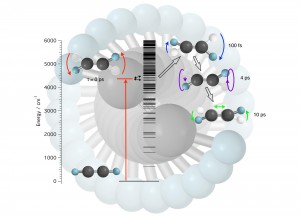Vibrational Conical Intersections in Methanol
The vibrationally adiabatic approximation separates the high frequency vibrations, such as the CH stretches in methanol, from the slow large-amplitude modes, such as the torsion and the COH bend angle in the figure above. Just as the electronically adiabatic surfaces defined under the Born-Oppenheimer approximation may meet in conical intersections, so too vibrationally adiabatic surfaces representing the frequencies of the high-frequency vibrations may meet in vibrational conical intersections (figure above). Where these surfaces meet like cones touching point-to-point the system may pass easily from one surface to the other leading to the expectation of ultrafast vibrational energy transfer localized at those places. Supported by the U.S. Department of Energy.

Sum-Frequency Generation at Buried Interfaces in Solar Photovoltaic Devices
The structure of molecules at surfaces and interfaces plays an important role in determining the efficiency of solar cells. Our understanding of these interfaces next to electrodes has been limited due to lack of experimental and simulation tools. Because of it symmetry requirements, sum frequency generation (SFG) is uniquely sensitive to the molecular structure at these crucial buried interfaces. The combination of infrared and visible SFG wavelengths allows vibrational spectra of interfacial molecules to be obtained. In this collaborative project with the Dhinojwala, Tsige, and Gujrati groups, we develop methods for the theroeticial simulation of SFG spectra with the aim of providing the means for a confident interpretation of such spectra. The target systems are poly 3-alkyl thiophenes at semiconductor surfaces.
Ultrafast Intramolecular Vibrational Energy Redistribution (IVR) in Acetylene
The spectroscopic vibration-rotation Hamiltonian of acetylene is known in detail thanks to the extensive high-resolution spectroscopic studies of Michel Herman, Badr Amyay and André Fayt. This Hamiltonian allows the calculation of the energy redistribution processes in acetylene in unprecedented detail. The IVR occurs in a hierarchical series of stages spread over several orders of magnitude in time. The volume of phase space explored is strongly dependent on the nature of the bright states and on the level of rotational excitation.

Large-Amplitude Motion and IVR in Methanol
Methanol exhibits rapid tunneling between three equivalent torsional minima. This large-amplitude torsional motion couples with other small-amplitude vibrations to rapid intramolecular energy redistribution (IVR) and to the formation of new kinds of vibrational motion at high levels of excitation. Experimental methods include slit-jet cavity-ringdown spectroscopy (in Akron) and rotationally-selected infrared spectroscopy (IR-FTMW) in collaboration with Prof. Brooks Pate of the University of Virginia. Supported by the U.S. Department of Energy.

Infrared Spectroscopy and Dynamics of Nitromethane
Nitromethane has a low 6-fold barrier to internal rotation that enhances internal energy redistribution. High-resolution slit-jet FTIR spectra, recorded at the Pacific Northwest National Laboratory by Robert L. Sams, have revealed several stages of intramolecular coupling. The dependence of the interactions on the rotational quantum number has enabled the identification of the coupling mechanisms. Supported by the U.S. Department of Energy.

Torsion-inversion-vibration Dynamics of Methylamine
The CH and NH vibrations of methylamine are coupled to the large-amplitude torsional and inversion motions. This research uses high resolution cavity ringdown spectroscopy to explore that coupling and to test the validity of the adiabatic separation of the large- and small-amplitude degrees of freedom. Supported by the U.S. Department of Energy.
Sub-Surface Soil Spectroscopy: Applications to Archaeology and Forensics
The probe pictured above may be inserted up to a meter into the ground to record visible and near-infrared reflectance spectra as a function of depth. This technique may be used to survey the chemistry of an archaeological site as an aid to planning the excavation or to document the content of native peoples sites so that they can be given protected status. Applications to forensics are also being developed. This project is a collaboration with three small businesses and was initially supported by a University of Akron seed grant.

Combustion of Layered Systems in Microgravity
Layered fuel-air mixtures are produced for methane with an airfoil and methanol by evaporation from the liquid fuel. Our experiment applies wave-length-modulated diode laser spectroscopy. Measurements are made in normal gravity on the laboratory bench top and in zero gravity in the 2-second drop tower at NASA Glenn Research Center. Supported by NASA.


